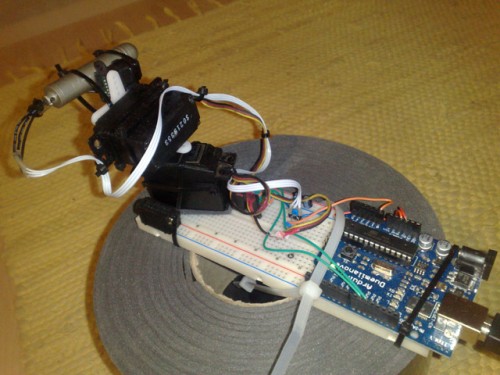Using the SHARP GP2Y0A02YK Long Distance Measuring Sensor (PDF), a few servos and an Arduino this 3D Arduino Scanner project is able to make a polar coordinate scan of its surroundings.
"The Arduino is only listening, the PC is sending commands where to set the Servos and to feedback the Analog value. On the PC a VB.net programm is running letting the Servos do a "meander style" motion and scanning the area. The analog Sensor signal is then first convertet to Distance, and then the polar is convertet to cartesian. This is stored as .obj file, that is then manualy "nice made" with MeshLab."



Permalink
Hello,
thanks Alan 🙂
Check out http://www.arduino.cc/cgi-bin/yabb2/YaBB.pl?num=1237928532 for some Code details.
Stephan Martin
Permalink
Permalink
That’s rather cool, I’ve thought of building a similar type of contraption but instead of measuring distance, measure heat with a thermoscanner (infra-red heat sensor like you get on those handheld devices with a laser pointer built in) so you can cheaply do a rudimentary thermal image of a building to show any heat loss – because have you seen how much thermal imaging devices cost? even the low resolution 160 x 120 ones can cost thousands
Permalink
Haku, the Idea wÃth the temperature sensor is great! Just need to make shure the “beam” from the sensor is narrow.
Permalink
The most narrow beam that I could find for a thermopile is 10 degrees FOV: MLX90614ESF-ACF. So distance will be pretty important because everything will start getting averaged together the further from the sensor it is. I’m working on the same sort of thing, but it will be an X/Y table above a catbox – see where I’m going with it? 🙂
Permalink
Permalink
Permalink
Permalink
Permalink
Permalink
Permalink
Permalink
Permalink
Permalink
Permalink
Permalink
Permalink
Permalink
Permalink
Permalink
Permalink
Permalink
Permalink
I’ve looked on the web for anyone who’s made a DIY thermal imager but nobody appears to have made one that I can find, most of the (few) forum discussions end up with people confusing IR light with IR heat, but I did find this rather neat robot sensor add-on which has an output for a single servo to do a pan scan: http://www.robot-electronics.co.uk/acatalog/Thermal_Array_Sensor.html
I take it if you ignored the servo connector and mounted it in your own X-Y servo setup you could scan a much larger area.
Permalink
Permalink
Permalink
Permalink
Permalink
Permalink